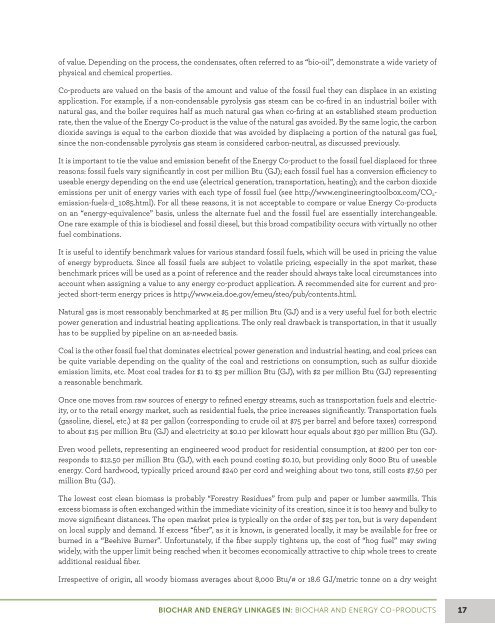U.S.-FocUSed Biochar report - BioEnergy Lists
U.S.-FocUSed Biochar report - BioEnergy Lists
U.S.-FocUSed Biochar report - BioEnergy Lists
Create successful ePaper yourself
Turn your PDF publications into a flip-book with our unique Google optimized e-Paper software.
of value. Depending on the process, the condensates, often referred to as “bio-oil”, demonstrate a wide variety ofphysical and chemical properties.Co-products are valued on the basis of the amount and value of the fossil fuel they can displace in an existingapplication. For example, if a non-condensable pyrolysis gas steam can be co-fired in an industrial boiler withnatural gas, and the boiler requires half as much natural gas when co-firing at an established steam productionrate, then the value of the Energy Co-product is the value of the natural gas avoided. By the same logic, the carbondioxide savings is equal to the carbon dioxide that was avoided by displacing a portion of the natural gas fuel,since the non-condensable pyrolysis gas steam is considered carbon-neutral, as discussed previously.It is important to tie the value and emission benefit of the Energy Co-product to the fossil fuel displaced for threereasons: fossil fuels vary significantly in cost per million Btu (GJ); each fossil fuel has a conversion efficiency touseable energy depending on the end use (electrical generation, transportation, heating); and the carbon dioxideemissions per unit of energy varies with each type of fossil fuel (see http://www.engineeringtoolbox.com/CO 2 -emission-fuels-d_1085.html). For all these reasons, it is not acceptable to compare or value Energy Co-productson an “energy-equivalence” basis, unless the alternate fuel and the fossil fuel are essentially interchangeable.One rare example of this is biodiesel and fossil diesel, but this broad compatibility occurs with virtually no otherfuel combinations.It is useful to identify benchmark values for various standard fossil fuels, which will be used in pricing the valueof energy byproducts. Since all fossil fuels are subject to volatile pricing, especially in the spot market, thesebenchmark prices will be used as a point of reference and the reader should always take local circumstances intoaccount when assigning a value to any energy co-product application. A recommended site for current and projectedshort-term energy prices is http://www.eia.doe.gov/emeu/steo/pub/contents.html.Natural gas is most reasonably benchmarked at $5 per million Btu (GJ) and is a very useful fuel for both electricpower generation and industrial heating applications. The only real drawback is transportation, in that it usuallyhas to be supplied by pipeline on an as-needed basis.Coal is the other fossil fuel that dominates electrical power generation and industrial heating, and coal prices canbe quite variable depending on the quality of the coal and restrictions on consumption, such as sulfur dioxideemission limits, etc. Most coal trades for $1 to $3 per million Btu (GJ), with $2 per million Btu (GJ) representinga reasonable benchmark.Once one moves from raw sources of energy to refined energy streams, such as transportation fuels and electricity,or to the retail energy market, such as residential fuels, the price increases significantly. Transportation fuels(gasoline, diesel, etc.) at $2 per gallon (corresponding to crude oil at $75 per barrel and before taxes) correspondto about $15 per million Btu (GJ) and electricity at $0.10 per kilowatt hour equals about $30 per million Btu (GJ).Even wood pellets, representing an engineered wood product for residential consumption, at $200 per ton correspondsto $12.50 per million Btu (GJ), with each pound costing $0.10, but providing only 8000 Btu of useableenergy. Cord hardwood, typically priced around $240 per cord and weighing about two tons, still costs $7.50 permillion Btu (GJ).The lowest cost clean biomass is probably “Forestry Residues” from pulp and paper or lumber sawmills. Thisexcess biomass is often exchanged within the immediate vicinity of its creation, since it is too heavy and bulky tomove significant distances. The open market price is typically on the order of $25 per ton, but is very dependenton local supply and demand. If excess “fiber”, as it is known, is generated locally, it may be available for free orburned in a “Beehive Burner”. Unfortunately, if the fiber supply tightens up, the cost of “hog fuel” may swingwidely, with the upper limit being reached when it becomes economically attractive to chip whole trees to createadditional residual fiber.Irrespective of origin, all woody biomass averages about 8,000 Btu/# or 18.6 GJ/metric tonne on a dry weight<strong>Biochar</strong> and energy linkages in: <strong>Biochar</strong> and Energy Co-products 17
















